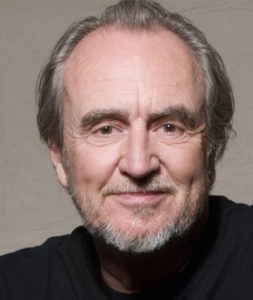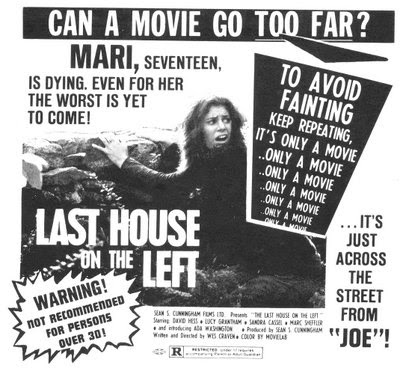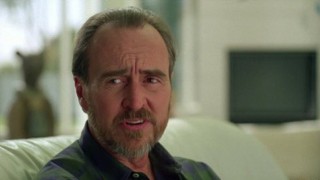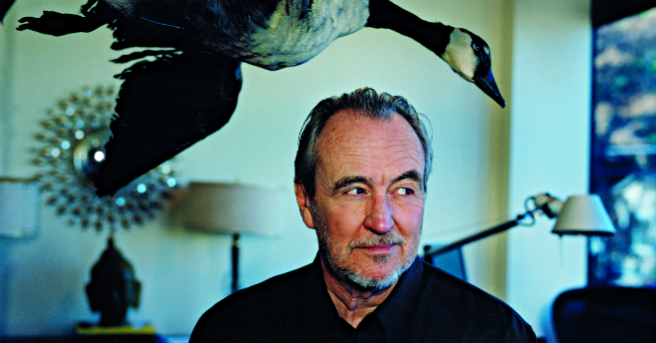Scream-maker Dead at 76
 This past weekend, not just the horror film community but the popular culture and world proper lost a good one. Many might not associate filmmaker Wes Craven, known for his gory horror output (his attempts to go beyond that genre ever unsuccessful, he came to embrace it) as one of “the good ones”. But upon inspection, one finds social, spiritual, intellectual and even artistic validation in his most notable work. On the sad occasion of Craven’s death from brain cancer, several ZekeFilm contributors gather here to share their personal recllections of the impact of his work. Wes Craven was 76. – Jim Tudor
This past weekend, not just the horror film community but the popular culture and world proper lost a good one. Many might not associate filmmaker Wes Craven, known for his gory horror output (his attempts to go beyond that genre ever unsuccessful, he came to embrace it) as one of “the good ones”. But upon inspection, one finds social, spiritual, intellectual and even artistic validation in his most notable work. On the sad occasion of Craven’s death from brain cancer, several ZekeFilm contributors gather here to share their personal recllections of the impact of his work. Wes Craven was 76. – Jim Tudor
Paul Hibbard (contributing writer)
Wes Craven saved me.
Well that’s not necessarily true, and is definitely hyperbolic, but after the death of someone you deeply respect, you tend to default to grandiosity. But it would be a true statement to say that Wes Craven saved me as a horror fan with a certain film he released in 1996.
 From my horror-loving childhood years, I already knew that Craven was as much an intellectual as he was a crafter of nightmares. Last House on the Left, his masterpiece debut, was about everything that was happening at the time. Distrust in the government; violent images coming home from Vietnam onto our TV sets; the Manson family and the idea of murderous hippies. To film fans, Last House on the Left could be called the official end of the 60’s and introduction to the cynical 70’s.
From my horror-loving childhood years, I already knew that Craven was as much an intellectual as he was a crafter of nightmares. Last House on the Left, his masterpiece debut, was about everything that was happening at the time. Distrust in the government; violent images coming home from Vietnam onto our TV sets; the Manson family and the idea of murderous hippies. To film fans, Last House on the Left could be called the official end of the 60’s and introduction to the cynical 70’s.
The Hills Have Eyes is about rural-life fear with a twist, as the fear was geared more towards the deserts of southwest instead of the typical Appalachian mountains of the southeast. With Craven’s knowledge of history, he also pulled from the stories of the 15th/16th Century Scottish cannibal Sawney Bean to materialize this terrifying movie.
“A Nightmare on Elm Street” will always be the film most associated with him, for good reason, it’s that good.
I’ve written about it. I admitted then, and still do today, my reading of it may be a stretch. Though knowing Craven’s, it may not be that much of a stretch.
Then along came the 90’s. Horror movies in the early-90’s sucked, to put it lightly. Sure some other countries were making some gems. For instance, Dellamorte Dellamore out of Italy and Dead Alive out of New Zealand. But none of that was on my radar as a Midwestern teenager.
 Then in 1996, Craven came out with Scream. I heard some positive buzz, but little did I know it was going to be his most perfect film. The film that was going to save me (again, hyperbole.) But the characters were all my age, the town of Woodsboro, Ca reminded me of my hometown. And the high school personalities were spot-on.
Then in 1996, Craven came out with Scream. I heard some positive buzz, but little did I know it was going to be his most perfect film. The film that was going to save me (again, hyperbole.) But the characters were all my age, the town of Woodsboro, Ca reminded me of my hometown. And the high school personalities were spot-on.
But the movie was everything a horror movie could be. Brilliant; so clever it hurt; hilarious; an homage to not only mainstream slashers, but also more underground Giallo films; and don’t forget, terrifying. I grew up in the 80’s, watching Friday the 13th movies in my childhood. Scream was the movie that grew with me. Smarter, more self-aware and referencing all of those movies I grew up watching along with being an encyclopedia of horror films of the past I have missed.
There’s always one horror franchise that represents a US President. Friday the 13th fit Reagan. Saw fit Bush. Paranormal Activity fits Obama. But the Scream franchise was the epitome of the Clinton years. If you liked Clinton, it was the representation of a smarter more aware generation of horror fans. If you disliked him, then a slicker more devious representation of where we were as a country.
Again, you may think that is too much reading into a horror franchise. But if you know, have studied, and love Craven, and know he has a Masters in philosophy and was a former humanities professor at Clarkson University, you may suspect that everything you are reading from his films is a connection to one of the most brilliant film minds of the last 30 years. And that is no hyperbole.

SCREAM 2 packed theaters in 1997.
Randall Yelverton (contributing writer)

Rachel McAdams in RED EYE (2005).
Wes Craven gave us Freddy Krueger and that will be how he is best remembered by future generations, but those curious about his career should seek out several interesting, less remembered projects Craven helmed. The Serpent and the Rainbow is a John Carpenter-like journey into Haitian voodoo that is as much of a thrilling adventure as it is horror film. The People Under the Stairs is a loony, nightmare of a movie about a child encountering some very evil neighbors. It’s an endlessly creative and adventurous film that horror fans should seek out. Red Eye is a fun and efficient thriller starring Rachel McAdams and Cillian Murphy. If you take out the credits sequences, the film is only about 80 minutes long. More thrillers should be this tight and focused.
Out of Craven’s entire oeuvre, my favorite film is Scream 2. It’s a sequel to the mega-hit meta-horror film Scream and is both more thrilling and funnier than its predecessor. Courtney Cox, David Arquette, and Jamie Kennedy have never been better on the big screen than they were in this. It’s a fast, funny, violent film that is a blast to watch. This, along with House of Wax, is the only film I’ve ever seen that benefitted from audience participation as we all gasped together and screamed “Dewey!” whenever Arquette’s dopey sheriff appeared on screen.
“Scream 2” shows Wes Craven at the peak of his showmanship powers.
Jim Tudor (ZekeFilm co-founder and site runner)
As a kid growing up in the 1980s, slasher films were ubiquitous in the realm of forbidden dangers. Jason Voorhees… Freddy Krueger… Wes Craven. The later of course, was not a movie murderer but was in fact the creator of many. “Wes Craven” – even his name is threatening, with the hard “ssss” and pointy, stabby “V”s and “W”s. As a naive seventh grader who managed to avoid gore films to that point, Craven’s work tended to live up to his name.
But something was different about his horror movies. They thankfully lacked the grating misogyny and objectifications so common in the genre. And they got me thinking.
Only later would I learn (via many media appearances and interviews) that Wes Craven the man was apparently not some deranged maniac with a movie camera, but was in fact warm, well-spoken, and personable.
That knowledge could not detract from my own experiences with his films. A Nightmare on Elm Street freaked me out sufficiently during a sleepover in the seventh grade, and enduring his The Hills Have Eyes alone in my parents basement remains one of my most harrowing film viewings. (To this day, I’ve been too chicken to watch his previous “brutal nasty”, The Last House on the Left).

Craven plays himself in NEW NIGHTMARE (1994).
And then there’s the meta-satisfaction of Wes Craven’s New Nightmare, followed by the fully satisfying Scream, which granted him his greatest box office success. That film opened quietly the same night as the much-hyped Beavis and Butthead Do America. I recall heading to the crowded multiplex that night with a group intent on seeing Beavis and Butthead. Based upon nothing more than some sort of odd film buff premonition, I secretly wanted to see Scream. With Beavis sold out, I got my wish. No one in the group regretted it. In the months that followed, Beavis and other films would come and go at the top of the box office charts, but like Freddy Krueger himself, Scream refused to die. The opposite reception of most popular horror movies, it sat firmly on the charts in the top five week after week. It was refreshingly vindicating to see that film worm its way into the zeitgeist. Freddy had company!
But let’s not rose-color everything. Craven’s filmography lists more mediocrity and outright duds than successes. But that said, when Craven connected, he connected big. Case in point remains his original Nightmare on Elm Street, in which he gave the world Freddy. Pretty obviously configured as a low-budget one-off, the 1984 film is not a tight nor well-made nor well-acted piece of cinema (despite introducing the world to Johnny Depp). But undeniably, there’s something there, something against all odds that renders it lasting as a moviegoing experience. It is something beyond the appealing catch-as-catch-can aesthetic, beyond the flat-out good idea of Freddy Krueger. (Who is by far the most interesting and compelling of his school of slashers, even before the rash of non-Craven sequels rendered the character a merchandise-friendly quipster. An unholy dream demon out to avenge the sins of the fathers that are buried in the American subburbs? That’s a bloody good movie idea, indeed!). No, it was not those things that gave that first film the power to keep Freddy alive. It is in fact the heart and soul of his creator, Wes Craven, piercing through.

Robert Englund as Freddy Krueger in A NIGHTMARE ON ELM STREET (1984).
Michael Allen (contributing writer)
Celebrity deaths are inevitable, but dammit, this one hurts.
Wes Craven was my ultimate horror movie director, the one who had more of an impact on my tastes than practically any other, and the one with hands down the coolest name out of all of them. Being a young spud who was obsessed with horror from an early age, I grew up watching A Nightmare on Elm Street constantly, appreciating the brilliance of its craft even at an early age. While the quality of his films could be inconsistent, he himself was never less than fully engaged: Interviews revealed Craven to be a deep, thoughtful, philosophical individual, one whose eloquence in conversation manifested itself as subtext in his films. It was he who brought a wider resonance to the slasher genre, one that transcended the limitations of the form, and, just as the genre was on the brink of winking out, it was he who brought it back to life.

THE PEOPLE UNDER THE STAIRS (1991).
While David Lynch is credited with bringing dream imagery to the mainstream, I would argue that Craven had an even greater influence, propelling subconscious symbolism into mass consciousness with the Nightmare series, and composing such films as The People Under the Stairs entirely in his dreams. Prior to Craven, dream sequences in horror films usually extended no further than fake-out scares punctuated by characters waking up in a cold sweat, giving filmmakers license to dabble in brief forays of surrealism before returning to the fold; Craven went all the way, utilizing universal fears to lend a greater heft to the events onscreen, tapping into a primal wellspring of unease that remains every bit as relevant and terrifying today.
His filmography is as varied as it is unique, bandying from slick blockbusters to gonzo freak-outs and back; while his roots lay in grindhouse cinema, he was adept at crafting MTV-ready entertainment, and launched the careers of many young stars in the process.
Seeing Scream in ’96 at age 13 was a defining moment, one that rocketed my already all-consuming horror fandom into overdrive by appealing directly to my love of the genre with metahumor and a deep reverence of the form. The collaboration of Craven and Scream writer Kevin Williamson was inspired, a pairing of like minds that yielded a perfect pastiche every bit as smart as it was scary, and it formed the foundation of every such film that followed.
While many of the directors who reshaped the genre are still kicking around in one way or another, Craven’s death marks the end of an era. The standard-bearer of horror movie hipness throughout his career, he was both punk rock and metal, eternally cool, and he discovered Johnny Depp to boot. No one could touch him; he was the best.

R.I.P. bird lover and filmmaker Wes Craven.

